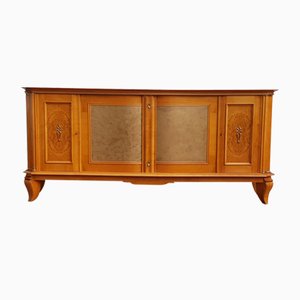
French furniture designer, sculptor, and architect André Arbus was born into a family of cabinetmakers in Toulouse in 1903. He worked in his father’s workshop while studying at the École des Beaux-Arts in Toulouse. After graduating, he became artistic director of the family business. In 1925, he began actively presenting his furniture designs in a variety of creative salons and galleries—including the Salon des Artistes Décorateurs, the Exposition des Arts Décoratifs, and the gallery L’Epoque in Paris—and quickly established a reputation as an innovative furniture designer. In 1932, Arbus moved to Paris, where he advocated a return to French tradition and quality. Inspired by French Classicism, his refined pieces embrace an economy of line as well as, often, luxurious materials such as lacquer, parchment, vellum, and fine wood veneers. He opened his own gallery in Paris in 1935.
In 1939, he exhibited work at the New York World’s Fair (designing the French sections at the Expo in New York and in San Francisco) and was commissioned to do the interiors of the French Ministry of Agriculture. From 1946 onwards, he exhibited widely and worked on a variety of interior design projects and objects, including a series of glass chandelier and light collaborations with the Parisian company Veronese, a variety of sea liner interiors, and a commission for the decoration of the French Embassy in Washington, D.C. (1955). During the 1950s, Arbus turned his attention towards sculpture and began to create unique sculptural furniture objects. His first bronze pieces appeared in 1952, and sculpture remained his primary focus until his death in 1969.

